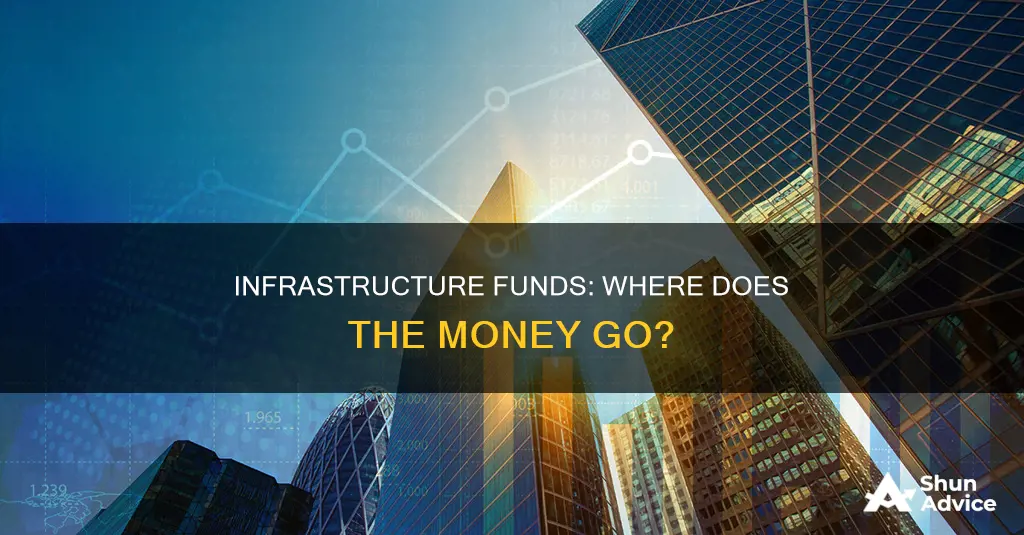
Infrastructure funds are a form of real assets that invest in physical assets that we see in everyday life, such as bridges, roads, highways, sewage systems, and energy. Infrastructure equity funds invest more than 60% of their assets in stocks of companies engaged in infrastructure activities. Industries considered to be part of the infrastructure sector include oil & gas, waste management, airports, shipping & ports, trucking, engineering & construction, and the utilities sector. Infrastructure funds are typically stable and non-cyclical, offering investors predictable free cash flows and strong, consistent returns, even through chaotic periods.
| Characteristics | Values |
|---|---|
| Industries | Oil & gas midstream, waste management, airports, integrated shipping, railroads, shipping & ports, trucking, engineering & construction, infrastructure operations, utilities sector, energy, mobility, digitization, healthcare, education |
| Investment Style | Equity funds, unlisted funds, listed funds, debt funds, value-add funds, opportunistic funds, distressed funds, core funds, core-plus funds |
| Investor Type | Institutional investors, individual investors, limited partners, high net worth individuals, retail investors |
| Returns | Steady, stable, strong, consistent, predictable, long-term |
| Risk | Low, predictable, non-cyclical, countercyclical, low variable costs, ESG risk, political risk |
| Investment Amount | $130 billion in 2021, $550 billion over the past 10 years |
What You'll Learn

Energy transition
In addition to renewable energy, infrastructure funds also invest in energy storage solutions, electric vehicle charging, and the modernization of energy transmission infrastructure. These investments aim to improve the reliability and resilience of the energy grid while supporting the wider adoption of renewable energy sources.
The U.S. Department of Energy (DOE), through the Bipartisan Infrastructure Law and the Inflation Reduction Act, is investing over $97 billion in clean energy infrastructure. This includes funding for energy efficiency in buildings, carbon management technology, and the development of a hydrogen industry to reduce emissions from carbon-intensive sectors.
Infrastructure funds also provide exposure to the North American energy infrastructure sector, including traditional midstream, natural gas, LNG infrastructure, and utilities. These investments offer stable cash flows and high barriers to entry for businesses.
Overall, infrastructure funds play a crucial role in driving the energy transition by providing the necessary capital to support the development and adoption of renewable and clean energy technologies.
SpaceX Investors: Fidelity Funds and Their Interests Explored
You may want to see also

Digitalization
The digitalization of infrastructure is a key process for enabling global sustainability and the transition to a green economy. Digitalization can help the infrastructure industry become more energy efficient and resilient to the effects of climate change.
Internet of Things (IoT)
The explosion of IoT in recent years has been a major driver of infrastructure digitalization. IoT devices collect data from physical infrastructure, which is then used by digital platforms to manage the infrastructure itself. This process is known as "platformization".
Data Layer
The data layer is a digital twin of the physical asset, providing opportunities to improve the organization of the system and develop new services. It also enables the creation of a "perpetual ride" or "perpetual lease", maximizing efficiency by reducing idle time.
Efficiency and Innovation
Platformization can lead to increased efficiency by optimizing the usage of resources and reducing waste. It also fosters innovation through the cooperation between providers and consumers, leading to the development of new business models and services.
Environmental Sustainability
Social Sustainability
The introduction of platforms into infrastructure management raises social challenges, particularly regarding equity, security, privacy, and democracy. Public intervention may be necessary to ensure that platforms are aligned with public values and the common good.
Financial Sustainability
Platformization can drain revenues from infrastructure providers, impacting their ability to invest in modernizing assets. Financial vehicles and private investments can help address this issue, with pension funds, foundations, and insurance companies being major investors in infrastructure.
Risks
The concentration of power in the hands of private companies managing global platforms can lead to market failure and negative externalities. Additionally, the high market power of platform managers can result in excessive control and negative consequences for prices in the ecosystem.
Opportunities
Debt Funds: A Smart Investment for Your Money
You may want to see also

Inflation reduction
Infrastructure funds are often invested in transportation, energy, and climate infrastructure projects. In the United States, the Bipartisan Infrastructure Law (BIL) directs $1.2 trillion of federal funds in these areas, with a focus on roads, bridges, broadband, public transportation, water infrastructure, and clean energy.
The Inflation Reduction Act (IRA) of 2022 is another critical piece of legislation aimed at reducing inflation and advancing climate action. The IRA contains $500 billion in new spending and tax breaks, with a strong focus on clean energy and climate action. Here are some key ways in which the IRA contributes to inflation reduction:
Clean Energy and Climate Action
The IRA provides nearly $400 billion in federal funding for clean energy initiatives, with the goal of substantially lowering carbon emissions by 2030. This includes investments in electric vehicles (EVs), clean energy manufacturing, and renewable energy sources such as wind and solar power. The act also establishes a national climate bank and supports climate-smart agriculture. These investments will help reduce greenhouse gas emissions and advance the transition to a clean energy economy.
Lowering Healthcare Costs
The IRA aims to lower prescription drug costs by allowing Medicare to negotiate prices with pharmaceutical companies and capping insulin costs at $35 per month for seniors. The act also extends Affordable Care Act (ACA) subsidies, resulting in an estimated $173 billion in savings for the federal government through 2031.
Raising Revenue
The IRA raises the minimum tax on large corporations to 15%, imposes a 1% excise tax on stock buybacks, and provides funding to enhance IRS collection and enforcement. These measures are expected to generate an additional $150 billion in tax revenue over the next decade.
Consumer Energy Savings
The IRA is projected to save American families up to $38 billion on electricity bills by 2030. This is achieved through tax credits and incentives for energy-efficient appliances, rooftop solar panels, and electric vehicles.
Job Creation
The IRA is expected to create over 1.5 million jobs over the next decade, with more than 170,000 clean energy jobs already created in the first year. These jobs are well-paying and contribute to economic growth, particularly in underserved communities.
Strengthening Energy Security
By investing in clean energy and reducing dependence on fossil fuels, the IRA strengthens America's energy security and reduces net crude oil imports. This diversification of energy sources enhances resilience and protects against price volatility.
Overall, the Inflation Reduction Act plays a crucial role in reducing inflation by addressing climate change, lowering healthcare and energy costs, creating jobs, and strengthening the economy. These measures contribute to a more sustainable and equitable future for Americans while also providing significant financial benefits.
PAN Card: Crucial For Mutual Fund Investment?
You may want to see also

Debt and value-add funds
Debt and value-add infrastructure funds are an increasingly popular choice for investors. They currently make up 13% and 22% of infrastructure fund AUM, respectively.
Debt Infrastructure Funds
Debt infrastructure funds are attractive to investors because they offer exposure to investments that provide essential services and have high barriers to entry. This results in long-term stable cash flows that are relatively immune to the macroeconomic environment.
The underlying assets of infrastructure debt are physical assets that we see in everyday life, such as bridges, roads, highways, sewage systems, or energy. These types of assets are crucial in a country's development and offer stable and predictable cash flows.
Infrastructure debt funds typically invest in debt linked directly to projects, rather than debt linked to a corporate entity. This type of debt is known as project finance, which allows a sponsor to shift risk off its balance sheet. It usually entails the creation of a new economic entity, and the income generated by this entity directly services the debt.
Value-Add Infrastructure Funds
Value-add infrastructure funds are a type of infrastructure fund that focuses on adding value to existing assets or developing new assets to enhance their value. They are considered to have a higher risk-return profile compared to core and core-plus infrastructure funds.
These funds are likely to have a closed-end structure, similar to traditional private equity funds, due to their focus on capital appreciation of the underlying assets. They may also have shorter holding periods and terms compared to lower-risk infrastructure funds.
Value-add infrastructure funds can be an attractive option for investors seeking higher returns and are willing to accept a higher level of risk.
Tax-Efficient Fund Investing: Strategies for Smart Returns
You may want to see also

ESG investing
ESG stands for Environmental, Social, and Governance risk. This is an important part of infrastructure investment. For example, when building a large highway or bridge through a certain region, it may disrupt the social community of the area. In addition, the construction phase may cause a lot of pollution and environmental hazards that need to be taken care of.
Infrastructure funds have been incorporating ESG in their investment strategies, from embedding it in their purpose and values to looking for value-creating opportunities, valuing targets, and working with management teams to boost the long-term value of assets.
Climate-resilient real estate and electric vehicles are the top green targets for European infrastructure funds, with the US, UK, and Asia in line for a surge in investments.
ESG is now being considered by credit rating agencies when providing their ratings on companies, which could affect their cost of capital and their ability to raise funds in the market, thus also impacting the value of a company.
Public levels of interest in ESG investment have grown significantly over the past 12 months. ESG factors are being interpreted in EU regulations as sustainable finance. The focus on ESG by investors, companies, governments, regulators, and consumers is going to increase, and climate change is a critical challenge for businesses.
Strategies for Investing Your Rainy Day Fund Wisely
You may want to see also
Frequently asked questions
Infrastructure funds are a form of investment in "real assets", which are physical assets that we see in everyday life, such as bridges, roads, highways, sewage systems, and energy.
Infrastructure funds are often seen as a safe investment due to their non-cyclical nature, which offers stable and predictable cash flows. They are also non-correlated with the stock market and have a lower risk profile.
Infrastructure equity funds invest more than 60% of their assets in stocks of companies engaged in infrastructure activities, including oil & gas, waste management, airports, shipping & ports, trucking, engineering & construction, and utilities.
Some examples of infrastructure funds include iShares US Infrastructure ETF, ProShares DJ Brookfield Global Infras, and Global X US Infrastructure Dev ETF.







